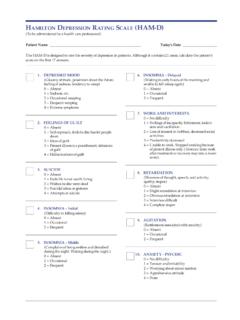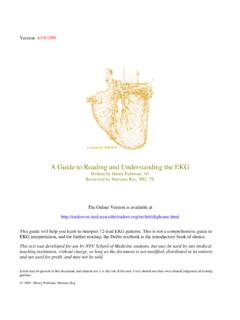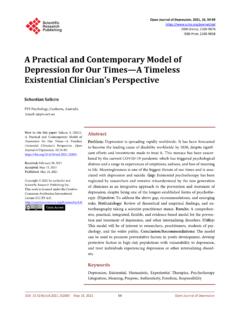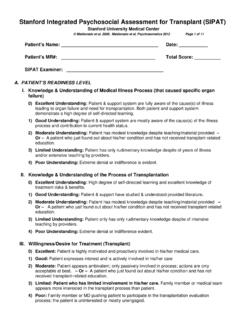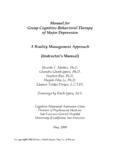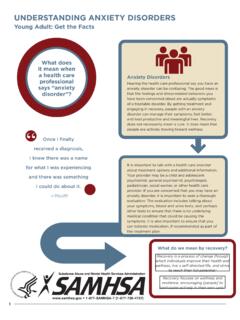Transcription of Understanding Elder Abuse - Centers for Disease Control ...
1 Understanding Elder AbuseFact Sheet 2016 Elder Abuse is an intentional act or failure to act that causes or creates a risk of harm to an older adult. An older adult is someone age 60 or older. The Abuse occurs at the hands of a caregiver or a person the Elder trusts. Six frequently recognized types of Elder Abuse include: Physical This occurs when an Elder experiencesillness, pain, or injury as a result of the intentional useof physical force and includes acts such as hitting,kicking, pushing, slapping, and burning. Sexual This involves forced or unwanted sexualinteraction of any kind with an older adult.
2 This mayinclude unwanted sexual contact or penetration ornon-contact acts such as sexual harassment. Emotional or Psychological This refers to verbal ornonverbal behaviors that that inflict anguish, mentalpain, fear, or distress on an older adult. Examplesinclude name calling, humiliating, destroying property,or not letting the older adult see friends and family. Neglect This is the failure to meet an older adult sbasic needs. These needs include food, water, shelter,clothing, hygiene, and essential medical care. Financial This is illegally or improperly using anelder s money, benefits, belongings, property, or assetsfor the benefit of someone other than the older include taking money from an older adult saccount without proper authority, unauthorized creditcard use, and changing a will without is Elder Abuse a public health problem?
3 Elder Abuse is a serious problem in the United States. There is a lack of data, but past research found that: In 2008, one in 10 elders reported emotional, physical,or sexual Abuse or potential neglect in the past Many cases are not reported because elders are afraid or unable to tell police, friends, or family about the violence. Victims often have to decide whether to tell someone they are being hurt or continue being abused by someone they depend upon or care for does Elder Abuse affect health? Elder Abuse can have several physical and emotional effects on an older adult.
4 Many victims suffer physical injuries. Some are minor, like cuts, scratches, bruises, and welts. Others are more serious and can cause lasting disabilities. These include head injuries, broken bones, constant physical pain, and soreness. Physical injuries can also lead to premature death and make existing health problems , 3, 4, 5 Elder Abuse can have emotional effects as well. Victims are often fearful and anxious. They may have problems with trust and be wary around is at risk for perpetratingelder Abuse ?Several factors can increase the risk that someone will hurt an older adult.
5 However, having these risk factors does not always mean violence will occur. Some of the risk factors for hurting an older adult include: Using drugs or alcohol, especially drinking heavily High levels of stress and low or ineffective copingresources Lack of social support High emotional or financial dependence on theolder adult Lack of training in taking care of older adult DepressionNational Center for Injury Prevention and Control Division of Violence PreventionUnderstanding Elder AbuseHow can we prevent Elder Abuse ?The goal is to stop Elder Abuse before it starts.
6 While not much research has been done, there are several important things we can do to prevent it: Listen to older adults and their caregivers to understand their challenges and provide support. R eport Abuse or suspected Abuse to Adult Protective Services. Educate oneself and others about how to recognize and report Elder Abuse . L earn how the signs of Elder Abuse differ from the normal aging process. Check in often on older adults who may have few friends and family members. P rovide over-burdened caregivers with emotional and instrumental supports such as help from friends, family, or local relief care groups; adult day care programs; counselling; or outlets intended to promote emotional well-being.
7 Where prudent and possible involve more people than just family, formal caregivers, and guardians in health care or financial matters. Encourage and assist persons (either caregivers or older adults) having problems with drug or alcohol Abuse in getting does CDC approach Elder Abuse ?CDC uses a 4-step approach to address public health problems like Elder 1: Define the problemBefore we can prevent Elder Abuse , we need to know how big the problem is, where it is, and whom it affects. CDC learns about a problem by gathering and studying data. These data are critical because they help decision makers send resources where they are needed 2: Identify risk and protective factorsIt is not enough to know that Elder Abuse is affecting a certain group in a certain area.
8 We also need to know why Abuse occurs. CDC conducts and supports research to answer this question. We can then develop programs to reduce or get rid of risk factors and increase protective factors. Step 3: Develop and test prevention strategiesUsing information gathered in research, CDC develops and evaluates strategies to prevent 4: Ensure widespread adoptionIn this final step, CDC shares the best prevention strategies. CDC may also provide funding or technical help so communities can adopt these strategies. Where can I learn more? Elder Abuse Helplines and HotlinesCall 1-800-677-1116 Always dial 911 or local police during emergencies.
9 National Center on Elder Institute on Institute of more information on Elder Abuse , visit Acierno R, Hernandez MA, Amstadter AB, Resnick HS, Steve K, Muzzy W, Kilpatrick DG. Prevalence and Correlates of Emotional, Physical, Sexual, and Financial Abuse and Potential Neglect in the United States: The National Elder Mistreatment Study. American Journal of Public Health 2010; 100:292 Anetzberger, G. The Clinical Management of Elder Abuse . New York: Hawthorne Press, American Medical Association. American Medical Association white paper on elderly health.
10 Report of the Council on Scientific Affairs. Archives of Internal Medicine 1990; 150 Lachs MS, Williams CS, O Brien S, et. al. The Mortality of Elder Mistreatment. Journal of the American Medical Association 1998; 280 Lindbloom EJ, Brandt J, Hough L, Meadows SE. Elder Mistreatment in the Nursing Home: A Systematic Review. Journal of the American Medical Directors Association 2007; 8(9):610-16. 1-800-CDC-INFO (232-4636)










